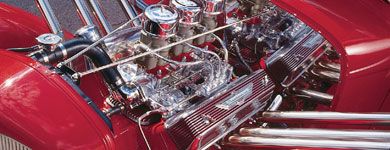
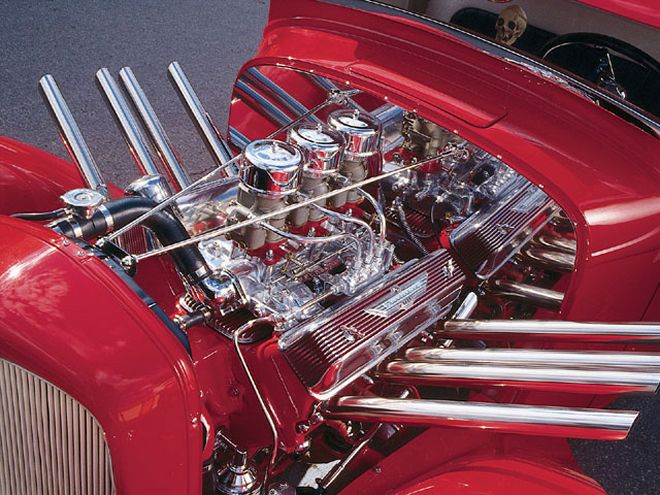 Paul Brewer's '34 pickup runs a very showy 292 Ford Y-block instead of a ho-hum crate motor. With stainless straight pipes, a vintage Offy intake with a trio of Strombergs, and polished Thunderbird aluminum valve covers, it gets attention.
Paul Brewer's '34 pickup runs a very showy 292 Ford Y-block instead of a ho-hum crate motor. With stainless straight pipes, a vintage Offy intake with a trio of Strombergs, and polished Thunderbird aluminum valve covers, it gets attention.
If one were going strictly by numbers alone, it would appear the new '54 Fords had the same Flathead V-8 they'd had for decades. The '53 and '54 Fords both offered a 239ci engine, but horsepower seemed to have jumped from 106 to 130. The difference was overhead valves. Ford had initiated the mass-produced Flathead V-8 some 22 years before and made some eight million of 'em, but at the end of the era found itself behind General Motors in the engine technology race, forcing Dearborn to finally jump into the inevitable and produce its first modern OHV V-8s.
If you're thinking of motive power for a new project car or truck and you have Blue Oval blood in your veins, you could easily pick one of a dozen great small-block crate engines from Ford. Or, you could pick from several choices in the Dearborn lineup of historical and cool vintage engines. This time around, we're examining the Y-block engines Ford would use for the immediate post-Flathead decade. They're trim enough to fit well in most street rod applications, can be dressed out quite nicely with goodies available today, and can be tweaked to provide a powerband decent enough to burn up some expensive rear Cokers!
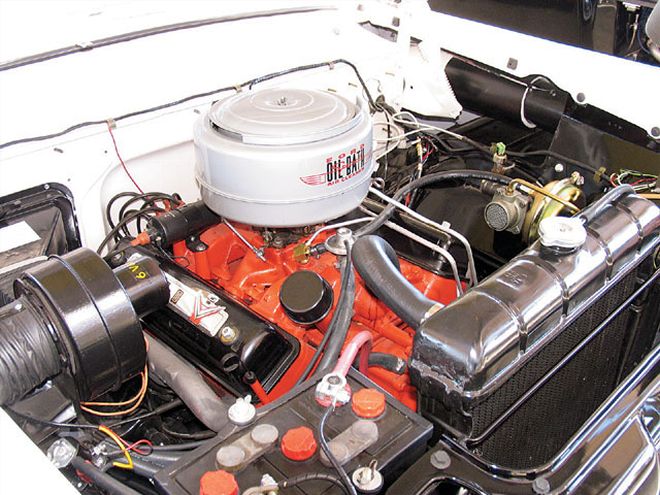 This restored '50s Victoria illustrates the Y-block engine in its original environment. With the right option package of carburetion, cam, and dual exhausts, these cars were taking on all contenders in '55-58 NASCAR races.
This restored '50s Victoria illustrates the Y-block engine in its original environment. With the right option package of carburetion, cam, and dual exhausts, these cars were taking on all contenders in '55-58 NASCAR races.
Y-Block HistoryPlanning at Ford for a newer V-8 had been going on since 1948, but the company made hundreds of trial engines for testing and didn't finalize a production version until the Y-block design (so nicknamed because of the deep skirt at the bottom of the block) debuted in 1952 in the Lincoln. The overall company plan was to use overhead-valve technology in all FoMoCo applications, but the new OHV six-cylinder and Lincoln V-8 arrived in dealerships first, then two years later in the Ford line for the masses.
Ford was in heated competition with rivals GM and Chrysler for the whole period of the 1950s and 1960s. It was a time of optimism, consumerism, and a burgeoning American economy. Buyers expected truly "new" car designs almost every year, with more chrome and options, and of course, increasing horsepower to back up the road-yacht image. GM started the horsepower race with the '49 Cadillac OHV Kettering-design 331ci V-8, followed by similar-but-different V-8s from Oldsmobile, Buick, Pontiac, and of course, Chevrolet's distinctively different small-block V-8s. Chrysler had introduced its wildly successful (looking in the rearview mirror with a hot rod perspective) Hemi-headed V-8s beginning in 1951, but as the number two manufacturer out of the three, Ford was most interested in staying ahead of Chevrolet.
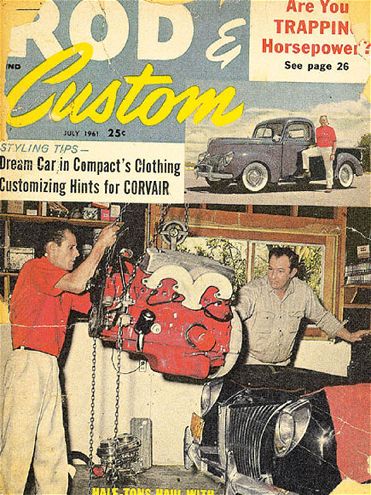 In 1961, R&C did a three-parter on installing a 312 'Bird motor in a '40 pickup. Doing all the work and dropping it in for the cover shot was the legendary Doane Spencer, who was R&C's tech editor at the time. Note the ram-horns exhausts, aftermarket valve covers, and the OEM dual quads on the floor.
In 1961, R&C did a three-parter on installing a 312 'Bird motor in a '40 pickup. Doing all the work and dropping it in for the cover shot was the legendary Doane Spencer, who was R&C's tech editor at the time. Note the ram-horns exhausts, aftermarket valve covers, and the OEM dual quads on the floor.
The new Y-block in the Ford line was substantially improved in almost every way when compared with the Flathead. The crankshaft was not only supported by the deep skirt of the block, but it had five main bearings, better oiling, and better cooling. From the start, they had the "oversquare" approach, with a bore larger than the stroke (3.50-inch bore and 3.10-inch stroke), but the compression was a weak 7.2:1, and the heads weren't the best for performance, although an enormous improvement over a Flathead in terms of breathing and chamber function.
Ford had only to worry about staying competitive with its three lines of cars-Ford, Mercury, and Lincoln-while GM and Chrysler both had five lines to worry about. In all of the Big Three companies, each line had to be perceived as having its own engines, even if the only difference between the models was that the higher-line cars had more cubic inches in the same engine design. Looking at the '54 Y-block engines, the Ford line started with a 239, the Mercurys had a 256, and the Lincolns continued the 317-incher they introduced in 1952.
For 1957, Ford took its Y-block game to its zenith, with a full lineup of powerplants. The base 272 now sported 190 hp, the 292 came in with 212, and the list of 312 options included a 245hp base four-barrel version and dual-quad models (now in passenger cars) with 270hp and 285hp levels. For the true hot rod gearhead, though, the ultimate T-bird option for 1957 was the 312 with a factory-installed Paxton/McCulloch centrifugal supercharger.
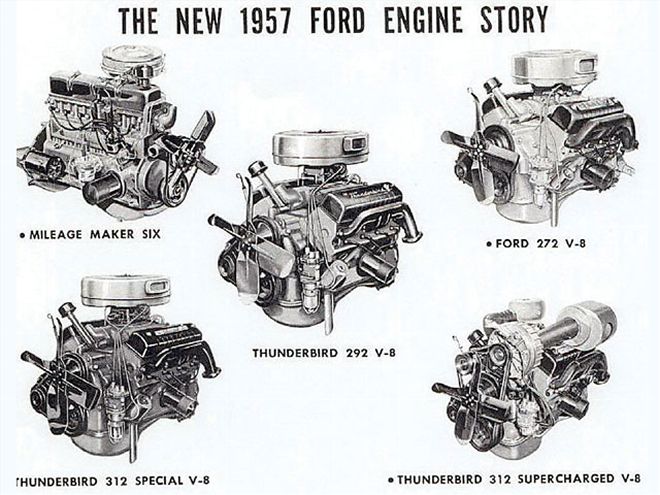 The Y-block parade for 1957 offered overhead V-8 power from 190hp 272s to the 292s and the 300hp supercharged T-bird 312. Not shown in the ad were the two "semi-production" dual-quad versions, the 270hp "High-Performance Special" and the 285hp "Racing" versions that were the hard-chargers on the track. (Photo courtesy of John Gambill, www.1957ford.com)
The Y-block parade for 1957 offered overhead V-8 power from 190hp 272s to the 292s and the 300hp supercharged T-bird 312. Not shown in the ad were the two "semi-production" dual-quad versions, the 270hp "High-Performance Special" and the 285hp "Racing" versions that were the hard-chargers on the track. (Photo courtesy of John Gambill, www.1957ford.com)
The compression ratio was held back a little to 8.5:1 to allow for 6 pounds of boost, and the blown Y-block still achieved an advertised 300 hp! We can't imagine any esteemed automobile manufacturer would flirt with the truth, but many contemporary observers of track times suggest theses were somewhat underrated. Some made 340 hp or more with a few "adjustments." All this was despite Ford realizing by 1957 that most Thunderbird buyers preferred a comfortable-but-distinctive country-club car over a potential road-race competitor, such as the Corvette. Only a little more than 200 blown 'Birds were sold. We all know the direction Thunderbirds went after that, but to give the Ford planners their due, the bigger and heavier '58 Thunderbirds with back seats sold almost as fast as Ford could produce them.
The Y-block had proven to be a successful powerplant for Ford, but the "bigger is better" handwriting was on the wall at Engineering, and in 1958 a new engine design, in 332ci and 352ci versions, was introduced and sold right alongside models with Y-blocks. We refer to that new engine design today as the great FE series (the subject of a later article in this series), which had the potential to be enlarged to greater displacements over its time in the marketplace, plus other improvements over the Y-block design. Over the next few years, the only passenger-car Y-blocks available were lower-horsepower versions of the 292, which eventually bowed out in 1962 in cars but continued a while after that in truck applications.
From showrooms across the country to heavy-duty trucking to NASCAR and speed records at Daytona Beach, the Y-blocks had proved worthy during their time in the combat-like competition between the automakers of the 1950s. It made a great successor to the venerable Flathead and bravely served "on point" for the legions of later Ford overhead engines to come.
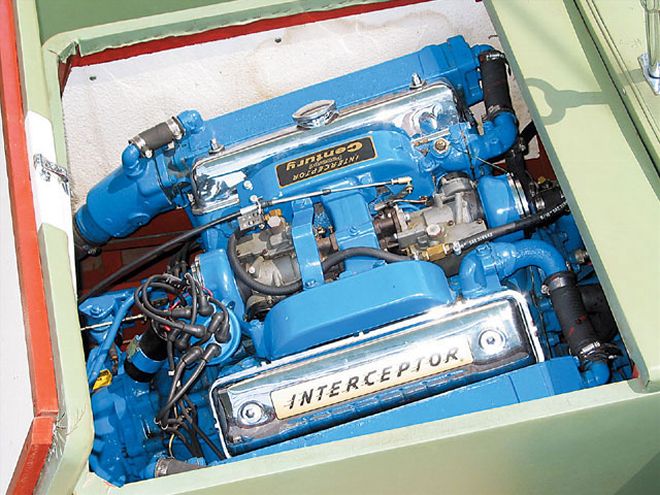 Builders of '50s-era performance boats were quick to adapt the Y-block overhead engines. Century was one of several companies making classic mahogany boats powered by the Interceptor line of 292 and 312 conversions. Note the special low-profile intake with dual Carter carbs. That and a shallow oil pan were necessary to fit an automotive V-8 under the engine cover.
Builders of '50s-era performance boats were quick to adapt the Y-block overhead engines. Century was one of several companies making classic mahogany boats powered by the Interceptor line of 292 and 312 conversions. Note the special low-profile intake with dual Carter carbs. That and a shallow oil pan were necessary to fit an automotive V-8 under the engine cover.
Y-Blocks In Street RodsIn comparison to the two engines previously examined in this series, the Y-block as a candidate for street rod use is more practical and popular than the semi-Hemi Mopars, although less utilized than the 348-409 Chevys. That last fact is one of the reasons you might consider a Ford Y-block for your next project. We've already seen increasing use of Y-blocks in cars featured within these pages, but selecting one of these engines will never categorize your ride as a bellybutton rod by a long shot. Good power, great looks, and decent power-to-weight ratio are all assets of the Y-block engines, and they fit better in most rod compartments than some of the big GM overheads.
Perhaps from their high profile in racing, Y-blocks stirred the imagination of rodders almost from the time they were introduced, so hungry were traditional guys for something Blue Oval to replace the Flathead and compete with the GM powerplants at the drags and street races. Hot Rod magazine and the little books had a number of articles about the Y-blocks, extolling the virtues of the five-main bearings, deep-skirted block, overhead valves, full-flow oiling, quench-type chambers, and a chaindrive camshaft (as opposed to the Flathead's geardrive).
The 1950s was a great period of socioeconomic change and a time when Americans were fascinated with the continuous parade of new technologies in travel, communications, entertainment, labor-saving devices for the homemaker, and of course, new cars every year. The Big Three did not disappoint, with "longer, lower, more powerful" being the bywords of each year's crop of new cars. Younger readers may not comprehend this, but in those heady days, families would surround the local dealerships as soon as the car carriers dropped off a load at intro time, and there were actually crowds at dealerships of every marque. The dads all did their research ahead of time, reading Tom McCahill's automotive columns in Mechanix Illustrated.
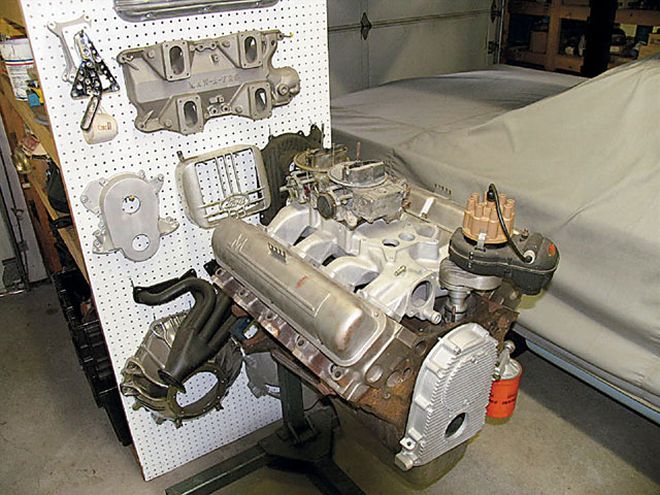 The Lincoln engines were a breed apart. This '59 430-incher represents two decades of collecting rare parts by Billy Belmont of Massachusetts. These blocks were somewhere between a Y-block and an FE, and they were designated the "MEL" (Mercury, Edsel, Lincoln) series. Bill's features N.O.S. M/T pistons, an Isky cam, a Cirello mag, a Weiand front cover, and a very rare '58 Mercury Turnpike Cruiser Tri-power.
The Lincoln engines were a breed apart. This '59 430-incher represents two decades of collecting rare parts by Billy Belmont of Massachusetts. These blocks were somewhere between a Y-block and an FE, and they were designated the "MEL" (Mercury, Edsel, Lincoln) series. Bill's features N.O.S. M/T pistons, an Isky cam, a Cirello mag, a Weiand front cover, and a very rare '58 Mercury Turnpike Cruiser Tri-power.
Motorsports was part of the process, as the hottest new cars duked it out on NASCAR tracks, when the race cars really were "stock cars." The Rocket 88 Oldsmobiles had their time in the sun for a year or two, then Hudsons ruled with their fast-off-the-corner six-cylinders. Ford was back in the game with the larger versions of its Y-blocks by the mid-1950s. Drivers such as Curtis Turner, Junior Johnson, Parnelli Jones, and Joe Weatherly were cleaning up with dual-quad Y-blocks. Besides all the Y-block wins in the regular races, NASCAR also ran a series from 1956-1959 that was all convertibles, and 26 of the 47 races were in Ford's win column in 1956, 22 of those by Curtis Turner. Chevrolet had introduced its lightweight small-block V-8 in 1955, but the 265 wasn't strong enough for the larger displacement competition. When its 283 V-8 came out in 1957, especially the rare "factory race cars" with the Rochester mechanical fuel injection, Chevrolet proved to be better competition; but Ford still outsold Chevrolet in 1957 on the streets and in the dealerships. In those days, it really was a case of "win on Sunday, sell on Monday."
As the oil companies struggled to come up with higher-octane fuels, the car manufacturers kept raising their compressions ratios to produce more power from the same basic engines. That was one way to escalate the advertised-horsepower stakes. The other was to increase the displacement. All the manufacturers had brought out new overhead V-8s during the 1950s, and in some cases, the original bore spacing and other design features of the first engines didn't allow for the accelerated growth that would take place over the next five years.
The Ford Y-block was one of those engine designs that, although a huge improvement over the Flathead, couldn't keep up with the constant displacement increases. It was increased to 272 ci for 1955 (just enough to be bigger than its rival's 265), and power increased to 162 hp, plus a "special" 272 with four-barrel, dual exhausts, and one-step-higher compression for a rated 182 hp. A 292-cube version was made available in the two-seater Thunderbirds introduced in 1955 that developed 198 hp. It wasn't the T-bird alone that drew crowds to the showrooms; the entire Ford line was radically restyled with bodies that remain as clean as any shapes produced in the mid-1950s, and assuredly collectible today. To be more competitive in NASCAR, a late addition to the 1955 engine lineup included a new 292ci version listed as a 205hp "police interceptor" option.
The following year was perhaps the "glory year" for Ford Y-blocks, with the introduction of the preeminent Y-block at 312 ci, in T-birds first and then in passenger cars. At compression ratios of 8.4:1 and 9.0:1, these babies produced 215 and 225 hp with a single four-barrel and dual exhausts, with a dual-quad option on the T-birds offering 245 hp. These were legendary engines on street, drag, and oval track venues. We know a few teenagers who ran them in Victorias in the 1960s with their street successes marred only by the number of annihilated clutches and stock three-speeds that littered the discard pile behind their garages. The solid-lifter Y-blocks could rev!
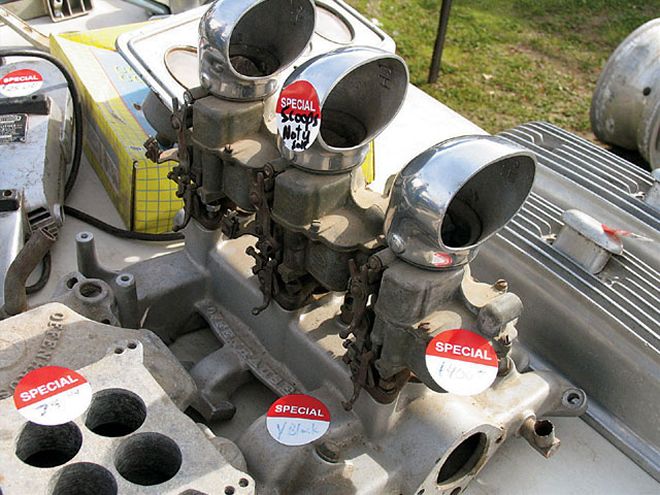 Aftermarket Tri-power setups show up at swap meets. The Offy manifold and three vintage carbs were offered at $400, minus the scoops. The same vendor had two pairs of vintage finned valve covers for $180 to $200 per pair.
Aftermarket Tri-power setups show up at swap meets. The Offy manifold and three vintage carbs were offered at $400, minus the scoops. The same vendor had two pairs of vintage finned valve covers for $180 to $200 per pair.
The speed equipment business, although not perhaps the "industry" it is today, was smaller and more responsive to new ideas, and the Southern California speed merchants were quick to experiment with the new Ford engines, quickly introducing intake manifolds, cams, and other goodies to further improve them. Luckily for hot rodders, chief Y-block designer Victor Raviolo planned for the new engine design to fit where a Flathead had resided in the company's '53 Fords. Offenhauser and other companies quickly set about to make cast-aluminum bellhousing adapters to attach 272-292-312 motors to traditional Ford transmissions, easing the transition from a Flathead to an overhead. Since brand-new engines take some time to trickle down to the wrecking yards where hot rodders mined for transplant horsepower, use of Y-blocks in hot rods continued well into the 1960s.
Y-block engines are not that hard to find these days; we've seen a few at swap meets and in local classified-ad tabloids, ranging in price from $300 to $600 for a complete. The most desirable are the bigger 292 and 312 versions, although a 272 with a few improvements will do. If you're going to pursue one, you'd be well-advised to search first for the back issues of STREET RODDER from the year 1999 that contain the excellent 10-part series Doc Frohmader did on building a Y-block, called "Y-Notta Y-Block." Although all but a few truck Y-blocks ('58-and-later heavy-duty 292s) had cast crankshafts, the block rigidity and crankshaft support of the Y-block's skirt makes a non-issue of using the stock crankshaft, with proper clearances and a professional balancing job.
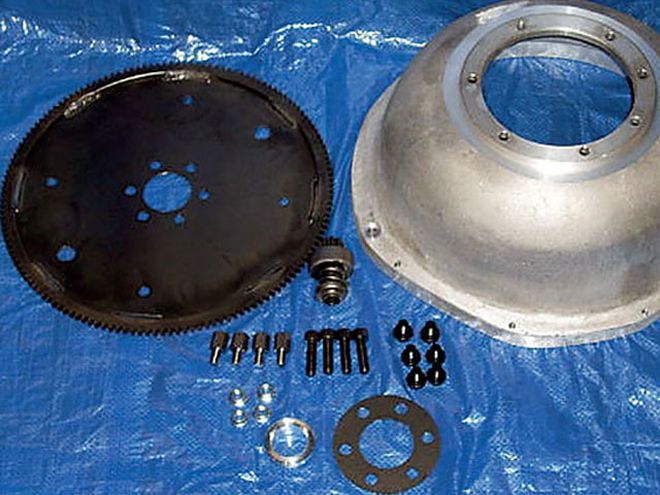 Y-blocks can be fitted with a wide choice of transmissions. Flat-o Products makes a C4 swap easy, just as the company has done for countless modern-built Flathead applications.
Y-blocks can be fitted with a wide choice of transmissions. Flat-o Products makes a C4 swap easy, just as the company has done for countless modern-built Flathead applications.
Mounting a Y-block in your street rod chassis is not a problem, either. Ford used two designs. The passenger cars all had side mounts on the block and a single trans mount to make up a pretty standard three-point support, while 'Birds and trucks used two somewhat close-together mounts on a bracket bolted through the front cover and two wide-spread mounts from the bellhousing, like early small-block Chevys. When mounting a modern transmission to a Y-block, it's desirable to make your engine mounts to fit the side-mount bosses on the block, and use a trans crossmember that accepts that transmission's mount. If you want to use a "small enough to fit where a stick goes" and dead-reliable C4 automatic, Flat-o Products (Salem, Oregon) makes a complete kit, and the company has a bellhousing with the two required mount ears on it for F-100 applications.
Wilcap (Pismo Beach, California) has a kit that will mount a GM TH350 behind the Y-block, plus a way to mount a '63-78 Ford Top Loader four-speed to your original Y-block stick bellhousing. Weir Products (American Canyon, California) has made its bones making adapter bellhousings to put late-model GM T56 six-speed transmissions behind vintage engines, and has been considering doing a model for the Y-blocks if enough interest is shown by customers. John Mummert (El Cajon, California) offers an adapter to mount the readily available T5 five-speed trans to a '54-64 Y bellhousing, including the S-10 T5 version that has the shifter in the right place for an early rod.
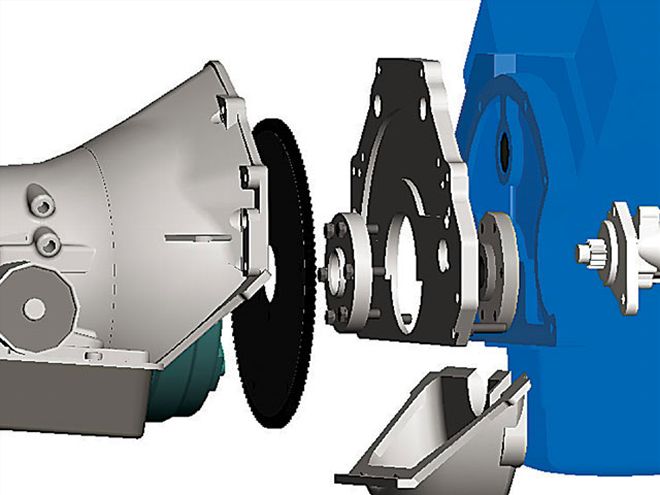 If you prefer a GM TH350 transmission, Wilcap offers this complete package of flexplate, machined bellhousing adapter, and GM flexplate-to-Y crank adapter. (Illustration courtesy of Wilcap)
If you prefer a GM TH350 transmission, Wilcap offers this complete package of flexplate, machined bellhousing adapter, and GM flexplate-to-Y crank adapter. (Illustration courtesy of Wilcap)
Performance for the Y-block, as with any engine, depends on your requirements and can be planned for with proper selection of camshaft, compression, and intake/exhaust components. All of the Y-blocks used solid-lifter camshafts with mushroom-type lifters, and grinds are still available from Clay Smith Cams, Red's Headers, and John Mummert. Cautions on camshafts are four-fold. Some cam catalogs listing Y-block offerings have a weak Stage 1 cam, then jump to grinds that are too wild. You want a stick with no more than 108-110 degrees of lobe separation for an engine with around 9:1 compression. Second, these engines have valve rotators, which will only work if the cam lobes have a slight side-to-side taper that induces the rotation, and the right amount of that taper isn't found on all available grinds. Third, the oiling for the rocker arms (lack of such is one of the original urban legends about Y-blocks) come from a passage leading upward from the center camshaft journal. In the old days, non-detergent oil, lack of maintenance, and absence of a PCV system could cause these passages to clog, starving the rockers. Y-block camshafts are made with an oil groove around the center journal, but the groove is too shallow on some contemporary grinds. Check the depth, and if it isn't 0.030- to 0.035-inch deep, turn the cam on a lathe to this dimension for proper oiling. Fourth, and this is important, remember that mushroom lifters are the first items installed in a Y-block rebuild, then the cam!
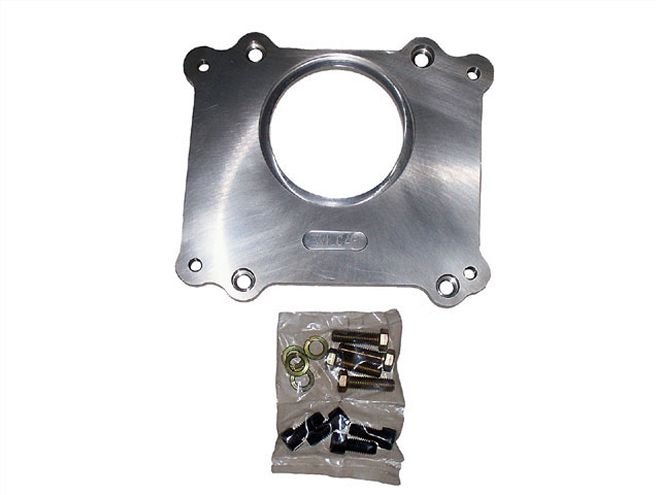 This Wilcap adapter and some other parts provide for simplified adaptation of late-model T5 five-speeds to the Y. The Mustang T5 is the easiest swap, but GMs can be done. (Photo courtesy of Wilcap)
This Wilcap adapter and some other parts provide for simplified adaptation of late-model T5 five-speeds to the Y. The Mustang T5 is the easiest swap, but GMs can be done. (Photo courtesy of Wilcap)
With a Web address like www.ford-y-block.com, it's no surprise Mummert has a full line of equipment for these engines, including rebuild kits, stroker kits, forged pistons, aluminum water pumps, high-ratio rocker arms, dress-up pieces, and even reproductions of the dual-quad air cleaners and cool ram-horns cast exhaust manifolds that were used on some truck engines. Red's Headers sells aluminum front timing covers for Y-blocks, and our friends at Sanderson (South San Francisco, California) have two headers designed for the Y-block applications. The guys at Gear Drive Speed & Custom (Lakeville, Minnesota) can set you up with kit or finished lakes-style outside headers.
The intake on Y-block engines is somewhat unusual, in that the ports are laid on top of each other-in other words, there are two groups of two ports on each side and each group is not side by side but over and under. Unless you find a period Ford single-four-barrel or dual-quad intake manifold, you have only two other choices: Scour the same swap meets or eBay for an Offenhauser or Edelbrock period aluminum Tri-power manifold (they're out there), or purchase a new Blue Thunder aluminum four-barrel manifold from John Mummert, whose company is just finishing development of a new aluminum manifold and aluminum Y-block heads. STREET RODDER will bring you details of these new products as soon as they're available.
Choosing a Y-block is relatively simple. Disregard the original 239-inch '54 engines, and look for a 272 or a 292, both of which can be made to meet your needs for a traditional street rod powerplant. Ah yes, the 312 is the largest of the Ford variants, but it's the most sought after, thus more costly. Additionally, the 312 was the only Ford Y-block with an asbestos-rope rear main seal, and they are prone to oil leaks here (ask any two-seater Thunderbird owner); all others had a lip seal, which works great. Another source of Y-block engines is your local boat yard, since many boats used inboard marine adaptations of the Y-block, often with dual-Carter one-barrel carbs just like the '53-54 Corvettes.
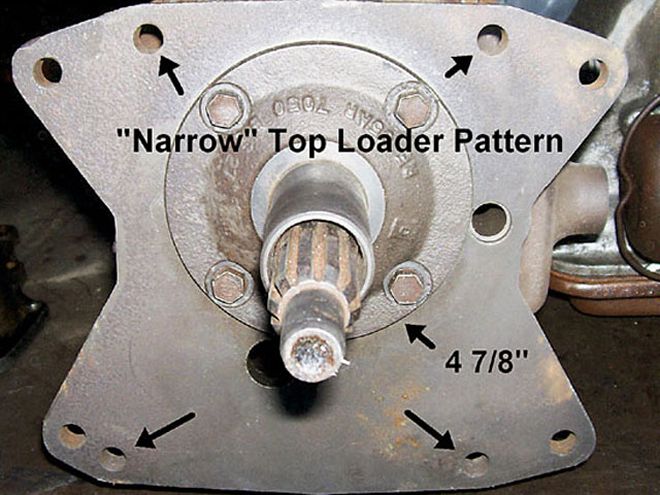 A bulletproof Ford Top Loader four-speed can be fitted to your stock Y bellhousing. Use a trans with the dual bolt pattern as shown; the passenger-car Y bellhousings have the narrow pattern. (Photo courtesy of Wilcap)
A bulletproof Ford Top Loader four-speed can be fitted to your stock Y bellhousing. Use a trans with the dual bolt pattern as shown; the passenger-car Y bellhousings have the narrow pattern. (Photo courtesy of Wilcap)
For cylinder heads, there were three intake valve sizes (all exhausts were the same at 1.510 inch): 1.64, '60-62 292s; 1.78, all '55-56; and the biggest at 1.93 inch were said to be only on the blown T-bird but were also used in '57-59 truck engines. When shopping for heads, bring your vernier calipers. Compression ratios were factory-achieved with different chamber volumes, but low-compression truck heads can be brought back up with the use of the right aftermarket piston domes. A standard performance treatment with heads and intake manifold port-matched to the gaskets and a three-angle valve job are a suggested part of your rebuild.
One of the traditional problems with Y-blocks has been cooling, but this can be addressed without much trouble. One of the reasons was the valve arrangement on the heads, where the exhaust valves for the two middle cylinders on each bank were immediately next to each other, causing a hot spot. The John Mummert aluminum water pump flows more water, which helps, but drilling two matching holes in the head and block deck helps this out further and at no cost. Using a head gasket as a template, mark the two holes between the two middle cylinders (see SR, Nov. '99) and drill the holes on the exhaust side to 1/4-inch, and the holes toward the intake side to 1/8-inch, then to 11/64-inch.
Cool valve covers are every street rodder's must-have, and for eyewash, we're all in luck here with the Y-block Fords. To someone who is a total Ford fan, there is no nicer OEM rocker cover on any engine to match the finned, polished-aluminum valve covers on the Thunderbirds, with that turquoise field for the 'Bird emblem. Originals can be found, and most of the Thunderbird restoration supply catalogs have a current reproduction of this. For the custom look, Offenhauser (see Exeter Auto Supply) still makes its polished cast-aluminum valve covers from the day, and Speedway Motors has chromed, repop OE steel covers and an ever-expanding group of cool Y-block parts in its catalog. To complete the impression, O'Brien Truckers (Charlton, MA) makes a nice finned-aluminum valley cover.
Y-block Ford engines were well thought of by gearheads back in the 1950s, and they can be even better with today's increasing availability of improved components. The modern transmission choices will allow you to put the engine in the powerband you want, without strain, and those solid lifters do sound more hot-rod than the sewing-machine-perfect modern crate engines. As Doc Frohmader said, "Y-not a Y-block" for your next traditional street rod.
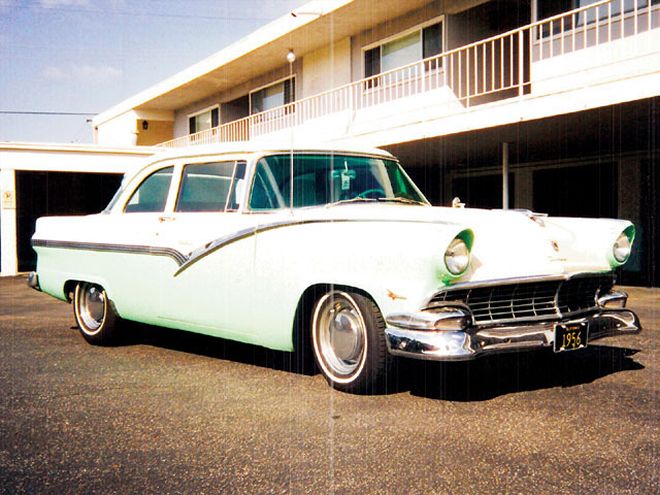
A Ramble About The Burble
Sound Observations From A Former Y-Blocker
The Y-block is probably one of the prettiest-sounding engines when run through cast-iron exhaust manifolds (the larger '57-and-later models for dual pipes are the best), car-length 2-inch pipes, and medium-length glasspacks installed roughly halfway along the pipe. Even though it may hurt torque a bit, resist the urge to install a balance tube or X between the pipes. Similarly, resist the urge to use chambered mufflers or large-diameter pipes. It's the wrong era and wrong sound for a Y-block, and neither will make a low-speed engine make any more power than the small pipes with 'packs will.
When set up that way, old dogs like Y-blocks have a smooth growl when cruising and have a pretty good bark when kicked with the right foot. In fact, without the balance tube, the pipes will rap under hard acceleration. You'll find yourself driving among high-rise buildings late at night just so you can hear the sound. It's pretty close to glorious. It's almost reason enough to own a Y-block-powered car. I miss the sound since I sold mine.